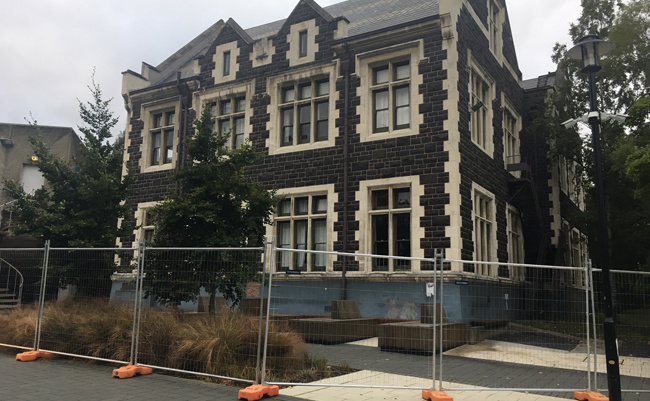Wednesday 11 March 2020 2:27pm

Barriers in place around the University's Consumer and Applied Science Building ready for earthquake strengthening work.
Staff and students are being relocated from the Consumer and Applied Science Building so it can be earthquake strengthened.
This will form part of the early works for a broader planned redevelopment of the Food Science precinct incorporating the CApSc and Gregory Buildings.
As a safety precaution, barriers have been installed outside the north, west and eastern sides of the CApSc building.
The barriers will affect access to the Archway Lecture Theatre and close the riverside path beside the CApSc building.
These barriers will remain in place for some time and the University apologises for any inconvenience.
Students and some staff have already moved out. Others will relocate soon, at a time which suits their schedules and the availability of premises.
Details of the changes:
- Postgraduate students have moved to the Archway Building at the south end of the Clocktower quad
- Administration staff are moving to the neighbouring Gregory Building this week
- Two seminar rooms have combined into one and relocated to the Gregory Building
- The bioengineering laboratory is relocating to Mellor Laboratories in the next few weeks
- The other laboratories are relocating to Mellor Laboratories in the next few months – including the lab in psychology’s Mellor Annex so they can all co-locate
- Use of the Food Hall building will continue as usual. The neighbouring CApSc wall is going to be supported
- The food caravan has been moved about six metres to the northwest
Proposed Food Sciences precinct redevelopment
Planning is underway for a wider programme redeveloping the Food Sciences department buildings.
Both the CApSc building and neighbouring Gregory building will be seismically strengthened and extensively refurbished.
The buildings will also be joined by a new first-storey link which will allow easy movement between laboratories and teaching and office space.
Seismic programme
The University of Otago has spent millions of dollars assessing its buildings for seismic risk over several years and is not facing this challenge alone. It is a nationwide issue.
By law, the Dunedin City Council has 15 years – from 1 July 2017 – to identify potentially earthquake prone buildings in its area and then the owners have 35 years to complete the strengthening work, but the University wants to complete this as soon as possible.
When planning the CApSc building’s strengthening and redevelopment, the Campus Development Division commissioned consulting structural engineers to examine the building because the last report was completed some time ago (August 2013).
The engineers used the more recent 2017 Ministry of Business, Innovation and Employment Technical Guidelines for the latest assessment which showed the building is below 20 per cent of New Building Standard (NBS). University policy – which is more stringent than the law – states the University will assess the risk at this level and, if appropriate, relocate everyone.
New buildings must be designed to withstand a one-in-500-year earthquake and the building’s seismic rating is based on the estimated earthquake hazard in Dunedin.
What could happen?
University of Otago Chair of Earthquake Science Professor Mark Stirling says while Dunedin is one of the least seismically active areas of New Zealand, there are still risks from nearby fault hazards but the timing for future events of the scale of the Christchurch cannot be predicted because earthquake science is not yet at the stage of predicting the day, exact location and magnitude.
There is evidence of magnitude 7 quakes at Taieri Mouth about 1,000 years ago. The only quakes in Dunedin in the 180 years since records began were a magnitude 5 in 1974 and a magnitude 4.7 in 2015 which caused minimal damage.
What would happen in an earthquake?
Knowing exactly how the 102-year-old building would react in an earthquake is still difficult because it depends on the type of shaking (strength, duration, and direction).
As a safety precaution, barriers are being erected around the building in case any masonry could fall off during an earthquake.
The CApSc building’s future
A range of options are being considered for the building’s long-term strengthening and refurbishment. That work will probably not be designed and approved until later this year. Construction should start early next year and be completed in late 2022.
